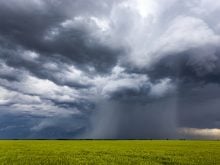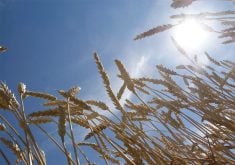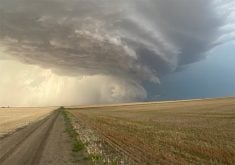Two summer weather events, rainfall and humidity, each have associated advisories and warnings.
Humidity, by its simplest definition, is the amount of water vapour in the air. The warmer the air, the greater the distance between air molecules and the greater the holding capacity for water vapour. Warm air can hold much more water than cold air.
Relative humidity is the most common way it is reported. Unfortunately, it is probably one of the most misunderstood terms used in describing weather.
Relative humidity is a ratio of the amount of water vapour in the air compared to the maximum it could hold under the same conditions, and is expressed as a percentage. For example, if we had an air temperature of 10 C and had eight grams of water vapour per kilogram of air, our relative humidity would be 100 percent, since air at 10 C can hold eight grams of water vapour. If this same air warmed to 30 C and the amount of water vapour didn’t change, the relative humidity would be around 29 percent, because air at 30 C can hold 28 grams.
Read Also

Short rapeseed crop may put China in a bind
Industry thinks China’s rapeseed crop is way smaller than the official government estimate. The country’s canola imports will also be down, so there will be a lot of unmet demand.
This is where misunderstanding develops. When the air temperature is 10 C and the relative humidity is 100 per cent, people say it is humid, but once the temperature has warmed to 30 C and the relative humidity drops to 29 percent, people say it is very dry. But the amount of water vapour in the air has not changed, only the temperature.
A better way to measure humidity is by using the dew point, the temperature at which air cools enough for condensation (or dew) to form.
For example, if it is 18 C outside early in the morning and the dew point is 18 C, the relative humidity is 100 percent. By the afternoon, as the air warms, the dew point would still be around 18 C if no additional water vapour was added or removed from the air, but the relative humidity would drop into the 50 percent range.
The best way to determine humidity is this:
- If dew point is less than 10 C, the atmosphere is fairly dry.
- Dew points in the 10-15 C range are comfortable.
- Dew points in the 15-20 C range are humid, starting to feel uncomfortable.
- Dew points over 20 C are very humid and feel very uncomfortable.
- Dew points over 25 C mean it’s extremely humid, conditions will be very uncomfortable and can even be dangerous.
In terms of severe summer weather, we don’t tend to think about heavy or extreme rainfall until it occurs.
Considering the impact of heavy rain and flooding, it far outweighs most other severe summer weather events.
What is a heavy or extreme rainfall event? According to Environment Canada, rainfall warnings are issued according to the following criteria.
If it is going to be a short-duration event, such as a thunderstorm, more than 50 millimetres of rain within one hour must be expected before a rainfall warning will be issued, at least across the Prairies.
It is lower over the East and West Coasts because they rarely get the intense thunderstorms seen inland.
If the rainfall event is expected to be longer, a warning is issued when 50 mm of rain is expected within 24 hours or 75 mm of rain is expected within 48 hours. Sometimes, due to the nature of summer storms, you can have both types of warnings at the same time.
Daniel Bezte is a teacher by profession with a BA in geography, specializing in climatology, from the University of Winnipeg. He operates a computerized weather station near Birds Hill Park, Man. Contact him at daniel@bezte.ca.
















